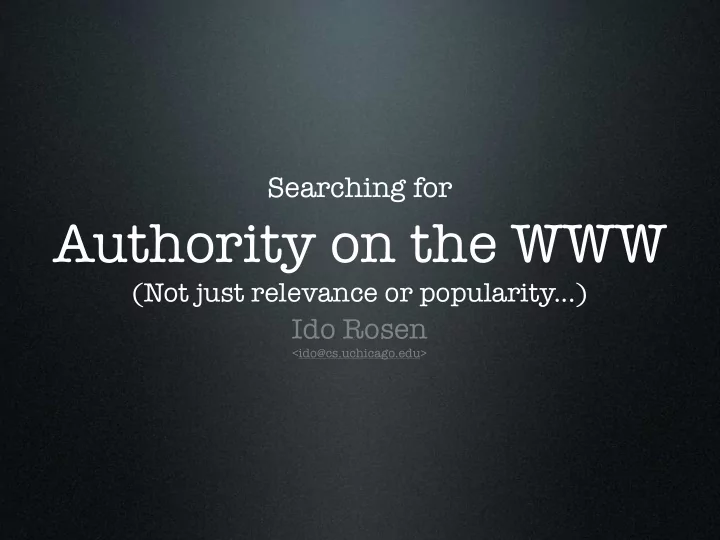

Searching for Authority on the WWW (Not just relevance or popularity...) Ido Rosen <ido@cs.uchicago.edu>
Sources of Information on the WWW • Textual content • Images, sounds, multimedia content • Hyperlink digraph (network structure) • Pages are vertices, links are arcs • Refinement: URLs are nodes
Nature of the WWW • Local organization may be a priori. • Global organization “utterly unplanned.” • Billions of agents (users, spiders). • Millions of publishers. • Trillions of vertices, at least. • Too big for simple search.
Searching the WWW • Quality of search method defined by utility of results. • Utility requires human evaluation. • Utility is closely correlated to relevance . • Algorithmic and storage efficiency are a concern: interactivity/response time.
Search: Queries • Searches are initiated by a user- supplied query . • Three types of queries discussed: • Specific queries. • Broad-topic queries. • Similar content queries.
Search: Problems. • Specific queries: Scarcity . • Required information is scarce and pages are hard to find. • Broad-topic queries: Abundance . • We only want the authoritative pages. (i.e.: Wikipedia itself, not ad-clones.)
Search: Authorities • Possible measures of authority: • Frequency of search term on page. • Problem: Self-descriptive . • Popularity of page. (rank by links in) • Problem: Obfuscation by hubs . • Analysis of link structure...
Hyperlinks • Claim: Hyperlinks indicate conferred authority . • Claim: Hyperlinks solve self-descriptive problem. • What about navigational links? • What about paid advertisements?
Popularity • In some cases, most authoritative pages aren’t self-descriptive. • Universally popular pages would be considered highly authoritative w.r.t any query string, when they are not.
Step 1: Constructing Focused Subgraph • Obtain root set, R , from textual search. • Relatively small, rich in relevant pages, but doesn’t contain most or many of strongest authorities. • Extremely few intra-R links. • Obtain base set, S , from R by adding any pages pointing to or pointed from R.
Figure 1: Expanding the root set into a base set. R → S
• What about navigational links? • Transverse vs. intrinsic links. • Delete all intrinsic links. • Caveats? • What about “Google Bombing”? • Set limitations on in-degree or out- degree on a per-domain basis.
Step 2: Computing Hubs and Authorities • Given our focused subgraph G, now what? • Popularity ranking by in-degree? • Popularity ≠ relevance. • Hub : links to multiple relevant authorities. • Authorities : high in-degree and overlap. • Hubs & Authorities: Mutually reinforcing.
unrelated page of large in-degree hubs authorities Figure 2: A densely linked set of hubs and authorities.
Iterative Algorithm • Subgraph G = (V, A). • Normalized weights, x<p> & y<p>. • Update operations, I & O. • Mutually reinforcing: • I: x<p> = ∑ y<q> ∀ q : (q, p) ∈ A. • O: y<p> = ∑ x<q> ∀ q : (p, q) ∈ A.
Figure 3: The basic operations. I & O
• x is a vector containing all x<p> • y is a vector containing all y<p> • Iterate(k): apply I & O and normalize. • Filter(c): obtain c largest coordinates. • Optimization of k is trivial: • x and y converge eventually. (3.1)
Iterate( G , k ) G : a collection of n linked pages k : a natural number Let z denote the vector (1 , 1 , 1 , . . ., 1) ∈ R n . Set x 0 := z. Set y 0 := z. For i = 1 , 2 , . . ., k Apply the I operation to ( x i − 1 , y i − 1 ), obtaining new x -weights x � i . Apply the O operation to ( x � i , y i − 1 ), obtaining new y -weights y � i . Normalize x � i , obtaining x i . Normalize y � i , obtaining y i . End Return ( x k , y k ). Iterate
Filter( G , k , c ) G : a collection of n linked pages k , c : natural numbers ( x k , y k ) := Iterate ( G, k ). Report the pages with the c largest coordinates in x k as authorities. Report the pages with the c largest coordinates in y k as hubs. Filter
Method Quirks • Textual search as black box. • Only probabilistically global. • Does not address scarcity problem.
Similar-Page Queries • “similar:www.example.com” • Very little modification necessary! • Obtain root set from in-pages search. • R = t pages pointing to p. • In-degree still not a good ranking.
Related Work • Standing in social networks. • Influence in scientific citation networks. • PageRank. (i.e.: WWW indices, no hubs)
Multiple Sets of H&A • What about ambiguous query terms? (Terms with several meanings.) • What about different contexts? • What about polarized issues? (Groups that won’t link to one another, but are debating the same topic.) • Clusters exist.
Diffusion and Generalization • Diffusion : pages corresponding to “broader” topics than the query string are returned, or reference page has insufficient in-degree. • Was the query string too specific? • Possible solutions? • Non-principal eigenvectors. • Textual approaches (i.e.: term-matching)
Conclusions • Abundance problem is harder each day. • Calls for search engines to consider more than simple relevance and clustering. • Growth of WWW makes indexing harder. • WWW search results must be global , WWW search process doesn’t have to be. • Quality of results is critical, more so as the WWW grows and becomes polluted.
Conclusions • WWW is social. (Social organization is represented.) • Further avenues: • User traffic pattern analysis. • Eigenvector-based heuristics. (LSA) • Link-based methods for other queries.
Recommend
More recommend